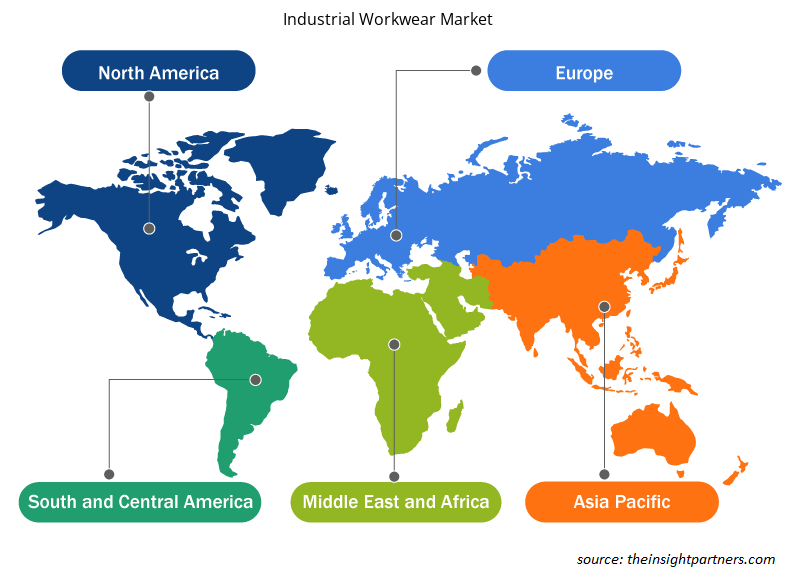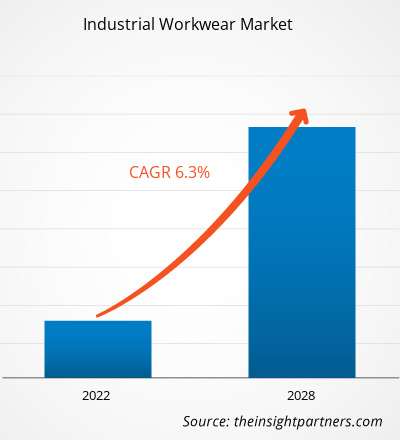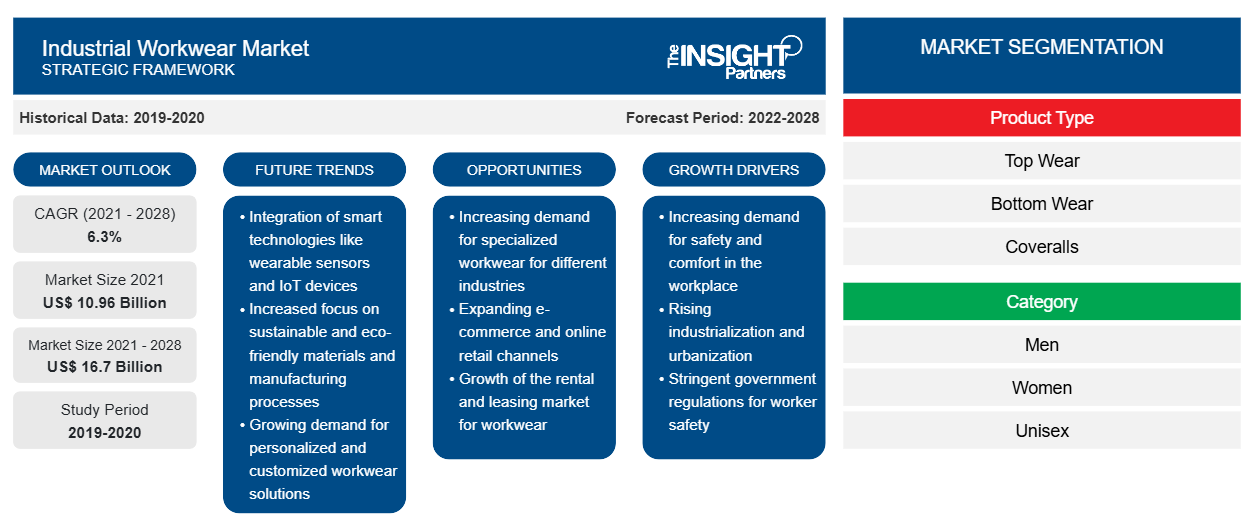산업용 작업복 시장은 2021년 10,956.69백만 달러에서 2028년까지 16,697.49백만 달러로 성장할 것으로 예상됩니다. 2022년에서 2028년까지 연평균 성장률 6.3%로 성장할 것으로 예상됩니다.
산업용 작업복은 근로자에게 안전을 제공하고 건강한 작업 환경을 보장합니다. 작업복은 석유 및 가스, 화학, 건설, 제조, 자동차, 농업 및 광업을 포함한 다양한 분야에서 널리 사용됩니다. 지난 몇 년 동안 산업 분야에서 근로자의 안전에 대한 우려가 빠르게 증가했습니다. 다양한 정부 및 안전 협회는 근로자의 안전을 보장하기 위해 산업 지침을 부과하고 있으며, 이로 인해 작업복에 대한 수요가 급증했습니다.
2020년에 북미는 글로벌 산업용 작업복 시장 에서 가장 큰 점유율을 차지했으며 아시아 태평양은 예측 기간 동안 가장 높은 CAGR을 기록할 것으로 추정됩니다. 중국과 인도를 포함한 아시아 태평양의 신흥 국가는 작업 안전 조치와 지출이 급증하고 있으며, 이는 주요 시장 참여자에게 충분한 기회를 제공합니다. 아시아 태평양은 산업 재해 증가, 열악한 인프라, 직장 사망률 감소를 위한 이니셔티브로 인해 눈에 띄는 산업용 작업복 시장입니다. 국제노동기구(ILO)가 발표한 2021년 보고서에 따르면 아시아 태평양에서는 매년 산업 재해 또는 업무 관련 질병으로 인해 110만 명 이상이 사망하는 것으로 기록되었습니다. 인도와 같은 국가는 가장 보호가 부족하고, 정보가 부족하며, 훈련이 부족한 인력을 보유하고 있습니다. 여성, 어린이, 장애인 근로자, 이주 근로자 및 소수 민족은 가장 큰 영향을 받는 인구 중 하나이며 종종 산업 재해에 연루됩니다. 따라서 산업 재해 및 부상을 줄이기 위해 건설, 제조, 석유 및 가스, 그리고 많은 산업이 직원의 작업 안전에 광범위하게 투자하고 있습니다. 따라서 작업 안전에 대한 인식이 높아짐에 따라 아시아 태평양 지역에서 산업용 작업복에 대한 수요가 늘어나고 있습니다.
귀하의 요구 사항에 맞게 이 보고서를 사용자 정의하세요
이 보고서의 일부 또는 국가 수준 분석, Excel 데이터 팩을 포함하여 모든 보고서에 대한 사용자 정의를 무료로 받을 수 있으며 신생 기업 및 대학을 위한 훌륭한 혜택과 할인 혜택을 이용할 수 있습니다.
- 이 보고서의 주요 시장 동향을 알아보세요.이 무료 샘플에는 시장 동향부터 추정 및 예측까지 다양한 데이터 분석이 포함됩니다.
COVID-19 팬데믹이 산업용 작업복 시장에 미치는 영향
COVID-19 팬데믹과 장기 봉쇄로 인해 석유 및 가스, 건설, 제조, 자동차, 화학 등 다양한 분야에서 산업용 작업복 제품에 대한 수요가 감소했습니다. 산업용 작업복은 다양한 산업 분야에서 작업장에서 근로자의 안전을 보장하기 위해 사용됩니다. 그러나 산업용 작업복 산업은 2020년 COVID-19 발병 동안 전례 없는 어려움에 직면했습니다. 산업용 작업복 제조업체는 전국적인 봉쇄, 무역 금지, 여행 제한으로 인한 공급망 제약으로 인해 상당한 어려움에 직면했습니다. 공급망의 혼란으로 인해 원자재가 부족해져 다양한 산업용 작업복 제품의 생산 및 유통에 영향을 미쳤습니다.
2021년에 정부가 이전에 부과한 제한을 완화한다고 발표하면서 다양한 경제권과 산업이 운영을 재개했습니다. 제조업체는 최대 용량으로 운영할 수 있었고, 이는 수요와 공급 격차를 극복하는 데 도움이 되었습니다. 따라서 작업복 제조업체는 사업을 되살리기 위해 생산량을 늘리는 데 집중했습니다.
시장 통찰력
엄격한 정부 규제 도입으로 산업용 작업복 시장이 활성화
전 세계적으로 근로자들 사이에서 직장 안전과 직장에서 발생할 수 있는 건강 위험에 대한 지식 부족은 심각한 우려 사항입니다. 이에 대한 인식을 높이기 위해 많은 정부 및 비정부 기구가 근로자의 건강과 안전과 관련된 다양한 프로그램과 캠페인을 도입하고 있습니다. American Standard Organization에 따르면 북미에서는 미국 노동부와 직업 안전 보건청(OSHA)이 직업 안전 보건 표준 분야를 표준화합니다. 보호복 표준 개발에 참여하는 기구로는 American Society for Testing and Materials(ASTM), National Fire Protection Association(NFPA), National Institute for Occupational Safety and Health(NIOSH), American National Standard Institute(ANSI), American Association of Textile Chemists and Colorists(AATCC), Industrial Safety Equipment Association(ISEA)가 있습니다. 따라서 안전을 보장하기 위해 산업용 작업복을 채택하기 위한 이처럼 엄격한 정부 규제를 도입하면 시장 성장이 촉진될 것으로 예상됩니다.
제품 유형 통찰력
제품 유형에 따라 산업용 작업복 시장은 상의, 하의, 오버올로 구분됩니다. 상의 부문은 예측 기간 동안 가장 큰 시장 점유율을 차지할 것입니다. 그러나 오버올 부문은 예측 기간 동안 가장 높은 CAGR을 기록할 것으로 예상됩니다. 오버올은 직장에서 인체 전체를 보호하기 위해 입는 단일 또는 이중 의류입니다. 이러한 오버올은 주로 나일론, 면, 폴리아미드 섬유로 만들어집니다. 이들은 일반적으로 높은 직업적 위험으로 인해 페인트 및 코팅, 석유 및 가스와 같은 화학 처리 공장 및 산업에서 사용됩니다. 이들은 근로자를 화학적, 기계적, 열적, 생물학적 위험으로부터 보호합니다. 게다가, 관리 기관에서 제정한 규정의 도움을 받아 증가하는 직업적 안전 및 인식은 산업용 작업복에 대한 수요를 크게 촉진했습니다.
카테고리 통찰력
카테고리에 따라 산업용 작업복 시장은 남성, 여성, 유니섹스로 구분됩니다. 남성 부문은 예측 기간 동안 시장 점유율이 가장 높을 것으로 예상되는 반면 유니섹스 부문은 예측 기간 동안 가장 높은 CAGR을 기록할 것으로 예상됩니다. 세계은행 그룹 2022년 6월 보고서에 따르면, 전 세계적으로 2021년 남성 노동력 참여율은 72%였습니다. 대부분의 남성이 다양한 산업 및 기업 부문에서 일하기 때문에 산업용 작업복에 대한 수요가 증가하고 있습니다. 게다가 세계보건기구(WHO)의 2021년 9월 17일 보고서에 따르면, 약 200만 명의 남성이 업무 관련 원인으로 사망했습니다. 따라서 근로자를 직업적 부상과 사망으로부터 보호하기 위해 제조업체는 내화성 및 단열 산업용 작업복과 같은 새로운 기술에 집중하고 있습니다. 이러한 작업복을 사용하면 직업적 사망 및 부상 수를 줄이는 데 도움이 됩니다.
최종 사용 통찰력
산업용 작업복 시장은 최종 용도에 따라 석유 및 가스, 건설, 화학, 자동차, 제조 및 기타로 세분화됩니다. 제조 부문은 2020년에 가장 큰 시장 점유율을 차지했습니다. 제조 부문에서 산업 사고의 주요 원인은 근로자가 위험한 작업 환경에 지속적으로 노출되고 근로자가 부상을 입을 수 있는 보호화를 구할 수 없기 때문입니다. 보호용 오버올, 장갑 및 슬리브, 캡/모자, 코트, 재킷, 셔츠, 양말, 소프트쉘 재킷, 스웨트셔츠, 바지, 안면 마스크, 페이스 실드, 조끼, 보호용 부츠 및 보호용 발가락 보호대가 있는 신발은 신체의 상체와 하체를 보호하고 안전하게 지키도록 특별히 설계되었습니다.
Carhartt, Inc.; ALSICO; A.LAFONT SAS; Honeywell International Inc.; Hultafors Group; Lakeland Inc; Aramark; Ansell Ltd.; VF Corporation; Mustang Workwear는 산업용 작업복 시장에서 활동하는 주요 기업입니다. 이러한 기업은 전 세계적으로 증가하는 소비자 수요를 충족하기 위해 신제품 출시와 지역 확장에 중점을 두고 있습니다. 이들은 광범위한 글로벌 입지를 갖추고 있어 전 세계의 많은 고객에게 서비스를 제공하고 결과적으로 시장 점유율을 늘릴 수 있습니다. 이러한 시장 기업은 신제품 출시와 지역 확장에 중점을 두고 특수 포트폴리오에서 제품 범위를 늘립니다.
산업용 작업복 시장 지역별 통찰력
Insight Partners의 분석가들은 예측 기간 동안 산업용 작업복 시장에 영향을 미치는 지역적 추세와 요인을 철저히 설명했습니다. 이 섹션에서는 북미, 유럽, 아시아 태평양, 중동 및 아프리카, 남미 및 중미의 산업용 작업복 시장 세그먼트와 지리에 대해서도 설명합니다.

- 산업용 작업복 시장에 대한 지역별 특정 데이터 얻기
산업용 작업복 시장 보고서 범위
| 보고서 속성 | 세부 |
|---|---|
| 2021년 시장 규모 | 109억 6천만 달러 |
| 2028년까지 시장 규모 | 167억 달러 |
| 글로벌 CAGR (2021-2028) | 6.3% |
| 역사적 데이터 | 2019-2020 |
| 예측 기간 | 2022-2028 |
| 다루는 세그먼트 | 제품 유형별
|
| 포함된 지역 및 국가 | 북아메리카
|
| 시장 선도 기업 및 주요 회사 프로필 |
|
산업용 작업복 시장 참여자 밀도: 비즈니스 역학에 미치는 영향 이해
산업용 작업복 시장은 소비자 선호도의 변화, 기술 발전, 제품의 이점에 대한 인식 증가와 같은 요인으로 인해 최종 사용자 수요가 증가함에 따라 빠르게 성장하고 있습니다. 수요가 증가함에 따라 기업은 제품을 확장하고, 소비자의 요구를 충족하기 위해 혁신하고, 새로운 트렌드를 활용하여 시장 성장을 더욱 촉진하고 있습니다.
시장 참여자 밀도는 특정 시장이나 산업 내에서 운영되는 회사나 기업의 분포를 말합니다. 주어진 시장 공간에 얼마나 많은 경쟁자(시장 참여자)가 존재하는지 그 규모나 전체 시장 가치에 비해 나타냅니다.
산업용 작업복 시장에서 운영되는 주요 회사는 다음과 같습니다.
- 카하트 주식회사
- 아라마크
- 알시코 그룹
- A. 라폰트 SAS
- 허니웰 인터내셔널 주식회사
면책 조항 : 위에 나열된 회사는 어떤 특별한 순서에 따라 순위가 매겨지지 않았습니다.

- 산업용 작업복 시장 주요 업체 개요를 알아보세요
스포트라이트 보고서
- 산업용 작업복 시장의 진보적인 산업 동향은 기업이 효과적인 장기 전략을 개발하는 데 도움이 됩니다.
- 선진국과 개발도상국의 산업용 작업복 시장 참여자들이 채택한 사업 성장 전략
- 2020년부터 2028년까지의 시장에 대한 정량적 분석
- 세계 작업복 수요 추산
- 산업용 작업복 시장에서 구매자와 공급자의 효율성을 설명하기 위한 포터의 5가지 힘 분석
- 경쟁 시장 시나리오를 이해하기 위한 최근 개발
- 산업용 작업복 시장 성장을 촉진하고 제한하는 요인과 더불어 시장 동향 및 전망
- 상업적 이익을 뒷받침하는 시장 전략을 강조하여 의사 결정 프로세스 지원
- 다양한 노드에서의 산업용 작업복 시장 규모
- 산업용 작업복 산업의 세부적인 개요와 역학
- 유망한 성장 기회가 있는 다양한 지역의 산업용 작업복 시장 규모
- 과거 분석(2년), 기준 연도, CAGR을 포함한 예측(7년)
- PEST 및 SWOT 분석
- 시장 규모 가치/거래량 - 글로벌, 지역, 국가
- 산업 및 경쟁 환경
- Excel 데이터세트
최근 보고서
관련 보고서
사용 후기
구매 이유
- 정보에 기반한 의사 결정
- 시장 역학 이해
- 경쟁 분석
- 고객 인사이트
- 시장 예측
- 위험 완화
- 전략 기획
- 투자 타당성 분석
- 신흥 시장 파악
- 마케팅 전략 강화
- 운영 효율성 향상
- 규제 동향에 발맞춰 대응























 무료 샘플 받기 - 산업용 작업복 시장
무료 샘플 받기 - 산업용 작업복 시장